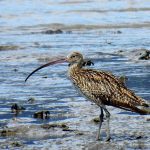EASTERN CURLEW
Numenius madagascariensis
The Eastern curlew is a large wader bird that is known for its impressive long-distance migrations and is found in various parts of the world, including Australia.
Eastern curlews are one of the largest shorebirds in the world, with long legs and a distinctive long, down-curved bill. They have mottled brown and white plumage, which helps them blend in with their coastal and estuarine habitats.
These birds are known for their incredible long-distance migrations. They breed in North-eastern Asia, particularly in Siberia, and then fly south to Australia during the non-breeding season to escape the harsh winters of the Northern Hemisphere.
In Australia, Eastern curlews are commonly found along the coasts and estuaries, especially in areas like mudflats, tidal flats, and saltmarshes. They are often seen in intertidal zones, foraging for food.
Eastern curlews primarily feed on a diet of crustaceans, mollusks, and marine invertebrates. Their long bills are well adapted for probing deep into the mud and sand to extract prey.
Eastern curlews are classified as “Endangered” in Australia, primarily due to habitat loss, degradation, and disturbance, as well as threats from climate change. These birds are sensitive to disturbances during their feeding and roosting times, which can affect their ability to rest and feed.
The Eastern curlew’s long migration is fraught with challenges, including the need for suitable stopover sites to rest and refuel along the way. They face threats such as habitat loss, pollution, and climate change throughout their migration routes.
Eastern curlews have a distinctive and haunting call that sounds like a drawn-out, melodious “curloo-oo.” Their calls can be heard in their breeding and wintering grounds.
Eastern curlews serve as an important flagship species for the conservation of intertidal habitats. Efforts to protect these birds often benefit a wide range of other species that rely on these ecosystems.
The Eastern curlew is a remarkable bird species that embarks on an epic journey from its breeding grounds in Asia to Australia during its non-breeding season. These birds are facing significant conservation challenges and are emblematic of the need to protect vital coastal and estuarine habitats. Conservation efforts are ongoing to safeguard their populations and the ecosystems they depend on.










